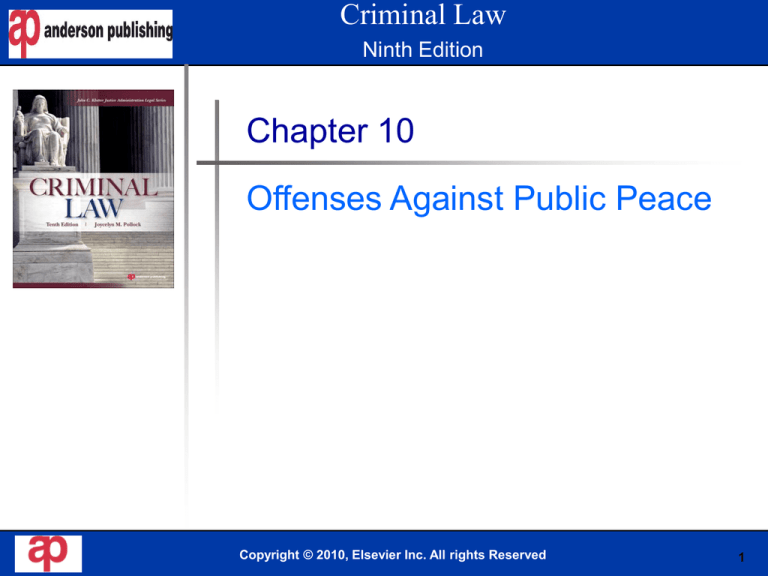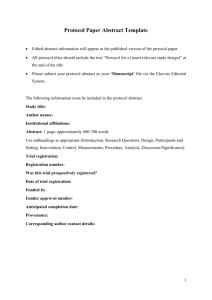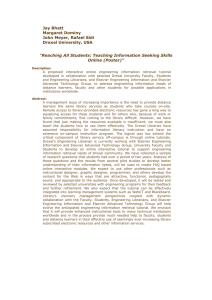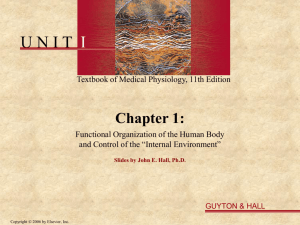
Criminal Law
Ninth Edition
Book
Cover
Here
Chapter 10
Offenses Against Public Peace
Copyright © 2010, Elsevier Inc. All rights Reserved
1
10.1
Introduction
The U.S. Constitution limits state power to enact
or enforce legislation that prohibit the free
exercise of individual behaviors.
The balance is to have criminal laws that prohibit
behavior that is dangerous and/or offensive to
the majority, while allowing the greatest degree
of freedom for the individual.
Copyright © 2010, Elsevier Inc. All rights Reserved
2
10.2
Riot and Related Offenses
In riot and riot-related offenses, the number of
participants must be greater than one to
constitute a crime.
In most instances, at least three or more persons
must be involved if the offense is to be classified
as a riot.
The three crimes of unlawful assembly, rout, and
riot represent the traditionally recognized steps
in violent mob action.
Copyright © 2010, Elsevier Inc. All rights Reserved
3
10.2
Riot and Related Offenses
Unlawful Assembly
Consist of:
The coming together of three or more persons with a
common purpose;
Either to commit a crime by open force; or
To carry out their common purpose, lawful or unlawful, in
such a manner as to cause persons of reasonable firmness
and courage to apprehend a breach of the peace.
Copyright © 2010, Elsevier Inc. All rights Reserved
4
10.2
Riot and Related Offenses
Rout
A rout is an unlawful assembly that has moved toward
the execution of the common purpose of the persons
assembled.
When an unlawful assembly moves toward the
accomplishment of the unlawful purpose, but no acts
of violence or disorder have occurred, a rout has been
committed.
Copyright © 2010, Elsevier Inc. All rights Reserved
5
10.2
Riot and Related Offenses
Riot
A riot is either an actual beginning of the execution of
an unlawful common purpose, or the execution of an
unlawful purpose by an assembly that was lawful
when its members first assembled; in each case, force
and violence are used to engender terror.
Copyright © 2010, Elsevier Inc. All rights Reserved
6
10.2
Riot and Related Offenses
Common Law
Riot was defined as a tumultuous disturbance of the
peace by three persons or more, assembling together
of their own authority, with an intent mutually to assist
one another against any who shall oppose them in
execution of some enterprise of a private nature and
afterward actually executing the same in a violent and
turbulent manner, to the terror of the people, whether
the act intended was, of itself, lawful or unlawful.
Copyright © 2010, Elsevier Inc. All rights Reserved
7
10.2
Riot and Related Offenses
Feinstein v. City of New York
Riot Elements
A number of persons, three at least;
A common purpose;
Execution or inception of the common purpose;
An intent to help one another by force if necessary against
any person who may oppose them in the execution of their
common purpose; and
Force or violence not merely used in demolishing, but
displayed in such a manner as to alarm at least one person of
reasonable firmness and courage.
Copyright © 2010, Elsevier Inc. All rights Reserved
8
10.2
Riot and Related Offenses
Common Law
Inciting to riot occurs when a person incites or
encourages other persons to create or engage in a
riot.
Inciting a riot is a separate, distinct offense from
participating in a riot.
Kasper v. State
The Supreme Court of Tennessee is 1959 affirmed that
inciting to riot is a common law offense.
Copyright © 2010, Elsevier Inc. All rights Reserved
9
10.2
Riot and Related Offenses
Model Penal Code
Does not carry forward the crimes of rout and unlawful
assembly.
Punishes for riot one who, under specific
circumstances, participates with two or more persons
in a course of disorderly conduct.
Copyright © 2010, Elsevier Inc. All rights Reserved
10
10.2
Riot and Related Offenses
State Statutes, Codes, and Cases
Some states’ statutes and codes follow the wording
of the Model Penal Code.
Some specify five, rather than three, as the number of
participants required to complete the crime.
The range of participants required ranges from 2–10
in state statutes.
The section of the Model Code that applies to
“disorderly conduct with the purpose of preventing or
coercing official action” is not common to most state
statutes.
Copyright © 2010, Elsevier Inc. All rights Reserved
11
10.2
Riot and Related Offenses
Summary
Riot has been a crime since common law, along with
related crimes.
Basically, what is necessary is at least three people
who undertake either unlawful action or lawful action
done in an unlawful manner.
Some states add the provision that the participants
may be obstructing the orderly process of government
or similar language.
Copyright © 2010, Elsevier Inc. All rights Reserved
12
10.2
Riot and Related Offenses
Riot
A/R
Three or more persons, undertake a common action, that is
unlawful or lawful but done in an unlawful manner, that is
violent and tumultuous and that obstructs orderly
government.
M/R
General Intent
Copyright © 2010, Elsevier Inc. All rights Reserved
13
10.3
Disorderly Conduct
Common Law
There was no offense known as “disorderly conduct,”
although misconduct that was of such a nature as to
constitute a public nuisance was indictable.
Copyright © 2010, Elsevier Inc. All rights Reserved
14
10.3
Disorderly Conduct
Model Penal Code
A person is guilty of disorderly conduct if, with
purpose to cause public inconvenience, annoyance or
alarm, or recklessly creating a risk thereof, he:
Engages in fighting or threatening, or in violent or tumultuous
behavior; or
Makes unreasonable noise or offensively coarse utterance,
gesture or display, or addresses abusive language to any
person present; or
Creates a hazardous or physically offensive condition by any
act which serves no legitimate purpose of the actor.
Copyright © 2010, Elsevier Inc. All rights Reserved
15
10.3
Disorderly Conduct
State Statutes, Codes, and Cases
The most common constitutional challenge to various
state disorderly conduct statutes was that they were
vague.
In order for conduct to rise to the level of disorderly
conduct, such conduct must be a breach of the peace.
Fighting is the most common.
Copyright © 2010, Elsevier Inc. All rights Reserved
16
10.3
Disorderly Conduct
Summary
Did not exist under common law.
Early statutes have been rewritten because they were
found to be unconstitutionally broad or vague.
Actions typically fall into the categories of: fighting;
threatening or tumultuous behavior; unreasonable
noise or obscene utterance or display; “fighting
words;” or actions that create a hazardous or
physically offensive condition.
Obscenity or speech that can be punished has been
listed as: the lewd and obscene, the profane, the
libelous, and the insulting of “fighting” words.
Copyright © 2010, Elsevier Inc. All rights Reserved
17
10.3
Disorderly Conduct
Disorderly Conduct
A/R
Fighting, offensive language (either obscenity or fighting
words), or other hazardous or dangerous actions—all must
tend to incite an immediate breach of the peace.
M/R
Intent, knowing, reckless
Copyright © 2010, Elsevier Inc. All rights Reserved
18
10.4
Vagrancy and Loitering
The early laws relating to vagrancy and loitering
have been declared unconstitutional.
Vagrancy historically referred to the status of
being homeless, penniless, and on the street or
simply being an unsavory character.
Loitering typically was defined as being
someplace in public without purpose.
Copyright © 2010, Elsevier Inc. All rights Reserved
19
10.4
Vagrancy and Loitering
Common Law
A person was deemed a “vagrant” who went from
place to place without visible means of support, was
idle and, although able to work for his maintenance,
refused to do so and lived without labor or on the
charity of others.
Early statutes in this country continued the common
law definition of vagrancy and basically criminalized
being a “street person” with no visible means of
support.
Copyright © 2010, Elsevier Inc. All rights Reserved
20
10.4
Vagrancy and Loitering
Papachristou v. City of Jacksonville
The Supreme Court ruled on a city ordinance that
defined vagrants as including rogues or vagabonds,
dissolute persons who beg, common gamblers,
jugglers, or those who engaged in unlawful games or
play, common drunkards, common night walkers,
thieves, pilferers, or pickpockets, traders in stolen
property, lewd, wanton, and lascivious persons, and
keepers of gambling places, among others.
The Supreme Court held that such an ordinance did
not give a person of ordinary intelligence fair notice
that his conduct was criminal and it also allowed for
arbitrary enforcement. Violated due process.
Copyright © 2010, Elsevier Inc. All rights Reserved
21
10.4
Vagrancy and Loitering
Model Penal Code
The actor must loiter or prowl in a place, at a time, or
in a manner not usual for law-abiding individuals and
under circumstances that warrant alarm for the safety
of persons or property in the victinity.
Copyright © 2010, Elsevier Inc. All rights Reserved
22
10.4
Vagrancy and Loitering
State Statutes, Codes, and Cases
Some states have enacted provisions patterned
closely after the Model Penal Code.
Others have enacted loitering statutes that are even
more specific.
Copyright © 2010, Elsevier Inc. All rights Reserved
23
10.4
Vagrancy and Loitering
Failure to Identify Statutes
A more recent issue is whether a state can make it a
crime to refuse to identify oneself to law enforcement.
Hiibel v. Sixth Judicial District of Nevada
The crime occurs when a police officer, with reasonable
suspicion that a crime has been or is about to be committed,
requests a person’s identity and they refuse to give it.
Copyright © 2010, Elsevier Inc. All rights Reserved
24
10.4
Vagrancy and Loitering
Summary
The common law crime of vagrancy basically
criminalized poverty.
The Supreme Court struck down Jacksonville’s
vagrancy ordinance as violative of the 14th
Amendment.
The Supreme Court has upheld failure to identify
statutes as long as the police officer has at least
reasonable suspicion to stop and detain for
investigation.
Copyright © 2010, Elsevier Inc. All rights Reserved
25
10.4
Vagrancy and Loitering
Loitering
A/R
Loitering or prowling; in a way not consistent with law-abiding
behavior, that creates a reasonable alarm or concern that
crime was imminent
M/R
Intentional, knowing
Copyright © 2010, Elsevier Inc. All rights Reserved
26
10.5
Drunkenness
Common Law
Drunkenness was not an offense under the common
law of England, but was punishable in the
ecclesiastical courts.
Under early state statutes, a person could be
punished for being under the influence of intoxicants
in a private or public place, or sometimes the penalty
applied only if the person appeared in an intoxicated
condition in public.
Copyright © 2010, Elsevier Inc. All rights Reserved
27
10.5
Drunkenness
Model Penal Code
Provides a penalty for appearing in public under the
influence not only of alcohol, but also of narcotics or
other drugs.
It also requires that the influence be to the degree that
the person charged may endanger himself or other
persons or property, or annoy persons in his vicinity.
Does not provide a punishment for private
drunkenness.
Copyright © 2010, Elsevier Inc. All rights Reserved
28
10.5
Drunkenness
State Statutes, Codes, and Cases
Some states adopted the provisions that follow the
Model Penal Code, while others have broader
coverage.
When the law applies only if the person is intoxicated
in a public place, the prosecution must prove that the
person did, in fact, appear in a public place while
under the influence.
Some statutes punish intoxication in private, often with
conditions attached.
Copyright © 2010, Elsevier Inc. All rights Reserved
29
10.5
Drunkenness
Driving While Intoxicated/Driving Under the
Influence
Some states use the terms interchangeably.
In other states, they are two different crimes.
Individuals have the right to refuse a breathalyzer test,
but state laws typically will respond to such a refusal
with a mandatory confiscation of one’s license.
Copyright © 2010, Elsevier Inc. All rights Reserved
30
10.5
Drunkenness
Summary
No common law crime of public drunkenness.
Early statutes made it a crime punishable in the
criminal court system.
Alcoholism cannot be used as a defense for public
intoxication, nor can drunkenness be used as a
defense for any crime.
Copyright © 2010, Elsevier Inc. All rights Reserved
31
10.5
Drunkenness
Public Drunkenness/Intoxication
A/R
Voluntary alcoholic intoxication (sometimes includes drugs),
in a public place (sometime private with other conditions);
sometimes offensive behavior is required even in a public
place
M/R
Intentional, reckless
Copyright © 2010, Elsevier Inc. All rights Reserved
32
10.6
Drug Laws
Beginning in 1970 with the Comprehensive Drug
Abuse Prevention and Control Act, statutes were
enacted by Congress to identify and control
substances that are extremely harmful when
used improperly.
The Uniform Controlled Substance Act defines a
large number of drugs and categorized them by
level of risk and seriousness.
Copyright © 2010, Elsevier Inc. All rights Reserved
33
10.6
Drug Laws
Common Law
There were no drug laws under the common law.
Model Penal Code
The Model Penal Code does not have any provisions
for drug possession or possession with intent to sell.
Drug intoxication is included with public drunkenness.
Copyright © 2010, Elsevier Inc. All rights Reserved
34
10.6
Drug Laws
State Statutes, Codes, and Cases
A state, under its police power, may regulate the
administration, sale, prescription, possession, and use
of narcotic drugs.
Statutes have been upheld in the following areas:
Possession of paraphernalia adapted for the use of narcotic
drugs and classification of marijuana as a narcotic.
Growing, possession, and use of marijuana.
Being under the influence of narcotic drugs.
Inhaling glue with the intent to become intoxicated.
The use of marijuana in a private place.
Copyright © 2010, Elsevier Inc. All rights Reserved
35
10.6
Drug Laws
Uniform Controlled Substances Act
Promulgated by the National Conference of
Commissioners on Uniform State Laws to create a
coordinated and codified system of drug control.
The Act sets out prohibited activities in detail, but
vests the authority to administer the Act in an agency
to be established by the state legislature.
To make the Uniform Act consistent with the federal
law, the Uniform Act follows the federal controlled
substances law and lists all of the controlled
substances in five schedules that are identical to
federal law.
Copyright © 2010, Elsevier Inc. All rights Reserved
36
10.6
Drug Laws
Uniform Controlled Substances Act
In categorizing the substances, eight criteria were
followed:
The actual or relative potential for abuse
Scientific evidence of pharmacological effects
The state of current scientific knowledge regarding the
substance
Its history and pattern of abuse
The scope, duration, and significance of abuse
What, if any, risks there are to the public health
Its psychic or psychological dependence liability
Whether the substance is an immediate precursor of a
substance already controlled
Copyright © 2010, Elsevier Inc. All rights Reserved
37
10.6
Drug Laws
Uniform Controlled Substances Act
All controlled substances are categorized in schedules
I, II, III, IV, or V.
Copyright © 2010, Elsevier Inc. All rights Reserved
38
10.6
Drug Laws
Uniform Controlled Substances Act
Schedule I
Has a high potential for abuse;
Has no currently accepted medical use in the United States;
and
Lacks accepted safety for use under medical supervision.
Copyright © 2010, Elsevier Inc. All rights Reserved
39
10.6
Drug Laws
Uniform Controlled Substances Act
Schedule II
The substance has high potential for abuse;
The substance has currently accepted medical use in
treatment in the United States, or currently accepted medical
use with severe restrictions; and
The abuse of the substance may lead to severe psychic or
physical dependence.
Copyright © 2010, Elsevier Inc. All rights Reserved
40
10.6
Drug Laws
Uniform Controlled Substances Act
Schedule III
The substance has a potential for abuse less than the
substances listed in schedules I and II;
The substance has currently accepted medical use in
treatment in the United States; and
Abuse of the substance may lead to moderate or low physical
dependence or high psychological dependence.
Copyright © 2010, Elsevier Inc. All rights Reserved
41
10.6
Drug Laws
Uniform Controlled Substances Act
Schedule IV
The substance has a low potential for abuse relative to
substances in schedule III;
The substance has currently accepted medical use in
treatment in the United States; and
Abuse of the substance may lead to limited physical
dependence or psychological dependence relative to the
substances in schedule III.
Copyright © 2010, Elsevier Inc. All rights Reserved
42
10.6
Drug Laws
Uniform Controlled Substances Act
Schedule V
The substance has low potential for abuse relative to the
controlled substances included in schedule IV;
The substance has currently accepted medical use in
treatment in the United States; and
Abuse of the substance may lead to limited physical
dependence or psychological dependence liability relative to
the controlled substances listed in schedule IV.
Copyright © 2010, Elsevier Inc. All rights Reserved
43
10.6
Drug Laws
Drug Crimes
Possession of a Controlled Substance Except as
Authorized
Possession statutes are comprised of two basic elements:
knowledge and possession.
Courts recognize constructive possession, which means that
the defendant has custody or dominion over the substance,
even if he does not have it on his person.
Copyright © 2010, Elsevier Inc. All rights Reserved
44
10.6
Drug Laws
Drug Crimes
Trafficking in a Controlled Substance Except as
Authorized
Trafficking involves a mens rea of knowing and specific intent
to deliver.
The actus reus is some type of delivery or transfer of a
controlled substance.
Copyright © 2010, Elsevier Inc. All rights Reserved
45
10.6
Drug Laws
Drug Crimes
Dispensing, Prescribing, Distributing, or Administering
a Controlled Substance Except as Authorized
The Uniform Controlled Substances Act and state statutes
require persons who engage in, or intend to engage in, the
manufacture, distribution, or dispensing of controlled
substances to be registered by the state.
Copyright © 2010, Elsevier Inc. All rights Reserved
46
10.6
Drug Laws
Drug Crimes
Seizure and Forfeiture of Controlled Substances,
Vehicles, and Drug Paraphernalia
Many states have enacted statutes that authorize seizure and
forfeiture of not only controlled substances, but any vessel,
vehicle, aircraft, or drug paraphernalia that has been used in
or was bought with the proceeds of drug trafficking.
Copyright © 2010, Elsevier Inc. All rights Reserved
47
10.6
Drug Laws
Drug Crimes
Challenges to Marijuana Laws
Opponents argue that marijuana should not be a schedule I
drug and that it should not have the same severe penalties as
other drugs.
Challenges based on individuals’ rights to privacy over
personal decisions have been raised.
Medical necessity defense.
Copyright © 2010, Elsevier Inc. All rights Reserved
48
Possession
A/R
Actual or constructive possession
M/R
10.6
Drug Laws
Knowing
Possession with Intent to Deliver
A/R
Actual or constructive possession; with circumstances
indicating intent is to deliver.
M/R
Knowing (goes to possession); specific intent (goes to
deliver/distribute)
Copyright © 2010, Elsevier Inc. All rights Reserved
49
10.6
Drug Laws
Trafficking
A/R
Actual or constructive possession; transfer or delivery (does
not have to be for money)
M/R
Knowing (goes to possession); general intent (goes to
delivering)
Copyright © 2010, Elsevier Inc. All rights Reserved
50
10.7
Wiretapping and Eavesdropping
Common Law
Eavesdropping was a common law crime.
An eavesdropper was that unsavory character who
snooped under the eaves to satisfy his interest in
gossip.
Copyright © 2010, Elsevier Inc. All rights Reserved
51
10.7
Wiretapping and Eavesdropping
Model Penal Code
Prohibits unlawful eavesdropping or surveillance.
Copyright © 2010, Elsevier Inc. All rights Reserved
52
10.7
Wiretapping and Eavesdropping
State Statutes, Codes, and Cases
Most states and the District of Columbia all have their
own laws governing the use of interception devices.
The United States Code, which defines the federal
crimes related to interception of wire, electronic, and
oral communications, does not preempt all state
crimes for similar behavior.
A state may impose greater restrictions than the
federal statute, but cannot authorize conduct that is
prohibited by federal law.
Copyright © 2010, Elsevier Inc. All rights Reserved
53
10.7
Wiretapping and Eavesdropping
Summary
The federal government cannot usurp entirely the
state’s power to criminalize wiretapping.
Usually the same act may be criminal under either the
state criminal code of the federal wiretapping statute.
Some states and the Model Penal Code have
included surveillance and video recording under
wiretapping prohibitions when it is done without the
consent or knowledge of the subjects.
Copyright © 2010, Elsevier Inc. All rights Reserved
54
10.7
Wiretapping and Eavesdropping
Eavesdropping/Wiretapping
A/R
Interception; of an oral communication; of one who has
reasonable expectation of privacy in those circumstances (in
some states, if at least one party consents it is lawful)
M/R
Willful/intentional
Copyright © 2010, Elsevier Inc. All rights Reserved
55
Common Law
There was no common law crime of terrorism.
Model Penal Code
10.8
State Counter-Terrorism Laws
The Model Penal Code does not have a provision for
terrorism.
State Statutes, Codes, and Cases
One of the first states to pass terrorism-specific
legislation was New York.
Copyright © 2010, Elsevier Inc. All rights Reserved
56
10.8
State Counter-Terrorism Laws
Summary
Federal terrorism laws, such as the Patriot Act, are
more often considered as the source for defining and
prosecuting terrorism as a crime.
Not all states have such laws, but those that do
basically concentrate on weapons of mass destruction
and threats to the general population.
Copyright © 2010, Elsevier Inc. All rights Reserved
57
10.9
Other Offenses Against the Public Peace
The offenses against the public peace all have in
common the aspect of victimization of the
general public, at least indirectly.
Constitutional protections, such as freedom of
speech and due process, require that the
statutes be written very narrowly and specify
targeted behaviors rather than vague categories
of undesirable behavior or people.
Copyright © 2010, Elsevier Inc. All rights Reserved
58
10.9
Other Offenses Against the Public Peace
Obstructing a Highway or Public Passage
Although the statutes and ordinances regulating the
use of streets and building have been upheld, these
must comply with the safeguards of the U.S.
Constitution, especially 1st Amendment safeguards.
Copyright © 2010, Elsevier Inc. All rights Reserved
59
10.9
Other Offenses Against the Public Peace
Harassment and Stalking
Harassment statutes and stalking statutes cover minor
assaultive conduct in which the intent is to annoy or
alarm a specific individual.
They have been challenged as unconstitutional in that
they infringe upon an individual’s freedom of speech
and movement.
Copyright © 2010, Elsevier Inc. All rights Reserved
60
10.9
Other Offenses Against the Public Peace
Desecration of Venerated Objects
Statutes that prohibit desecration of public
monuments or objects, places of worship or burial, the
national or state flags, or any other patriotic or
religious symbol are present in most states.
These statutes are aimed at special kinds of public or
quasi-public property damages that result in an affront
to members of the public.
Copyright © 2010, Elsevier Inc. All rights Reserved
61





